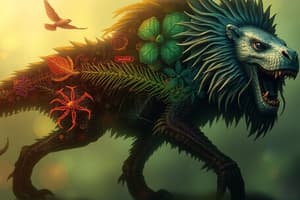Podcast
Questions and Answers
What is the primary function of the force that drives the animal forward?
What is the primary function of the force that drives the animal forward?
- To enhance agility in circular motions
- To create rotational movement around the main axis
- To provide stability during motion
- To propel the animal in the direction of movement (correct)
What type of force is responsible for rotating the animal?
What type of force is responsible for rotating the animal?
- Lateral force in the direction of movement
- Directional force providing propulsion
- Gravitational force aiding motion
- Rotational force with respect to its main axis (correct)
Which of the following best characterizes the two types of forces created by the waves?
Which of the following best characterizes the two types of forces created by the waves?
- One regular and one irregular force
- One static and one dynamic force
- One forward-driving and one circular force (correct)
- One linear and one non-linear force
In what direction does the force that moves the animal forward act?
In what direction does the force that moves the animal forward act?
What can be inferred about the forces created by these waves?
What can be inferred about the forces created by these waves?
What is a defining feature that leads most zoologists to classify certain organisms as animals?
What is a defining feature that leads most zoologists to classify certain organisms as animals?
Why is the contractile vacuole system important in the classification of organisms?
Why is the contractile vacuole system important in the classification of organisms?
Which of the following would NOT be a reason to classify an organism as an animal?
Which of the following would NOT be a reason to classify an organism as an animal?
How do zoologists primarily differentiate between animals and plants?
How do zoologists primarily differentiate between animals and plants?
Which statement accurately reflects the view of most zoologists on organism classification?
Which statement accurately reflects the view of most zoologists on organism classification?
Flashcards
Animal Classification
Animal Classification
Zoologists classify certain organisms as animals based on specific characteristics.
Contractile Vacuole
Contractile Vacuole
A system found in some organisms, used for water regulation.
Plant Kingdom
Plant Kingdom
A biological kingdom containing plants, distinguished by certain traits.
Organism Classification
Organism Classification
Signup and view all the flashcards
Zoologists' Belief
Zoologists' Belief
Signup and view all the flashcards
Wave forces
Wave forces
Signup and view all the flashcards
Driving force
Driving force
Signup and view all the flashcards
Rotating force
Rotating force
Signup and view all the flashcards
Animal movement
Animal movement
Signup and view all the flashcards
Wave's impact
Wave's impact
Signup and view all the flashcards
Study Notes
Systematic Zoology/Animal Taxonomy
- Is the branch of zoology that focuses on identifying, describing, naming, and classifying animals.
- Includes understanding the relationships between different animal types.
- Origins of the term "systematics" come from the Latinized Greek word "systema," meaning "to put together."
- Linnaeus used the term "systematics" in the 4th edition of his book "Systema Naturae" in 1735.
- Simpson (1961) defined systematics as the scientific study of the diversity of organisms and their relationships.
Early Animal Classification
- Aristotle (384-322 BCE) was an early zoologist and attempted to classify animals.
- His classification was based on observable characteristics like blood presence and birth method.
- He categorized animals into aquatic, terrestrial, and aerial groups.
Linnaean System of Classification
- Carl Linnaeus (1705-1778) developed the classification system commonly used today.
- His system employs binomial nomenclature (Genus species).
- Genus categorizes animals sharing many similar characteristics.
- Species categorizes animals with similar characteristics capable of interbreeding.
Hierarchy of Classification
- The classification system is hierarchical, starting with the most inclusive kingdom and progressing to less inclusive categories down to species..
- The hierarchy includes Kingdom, Phylum, Class, Order, Family, Genus, and Species (sub categories are also employed)
- Using Latin is essential in the naming of animal species.
Protozoa Classification
- Protozoa are single-celled organisms.
- They are classified into Subkingdom Protozoa, with four subphyla based on locomotion: Mastigophora (flagella), Sarcodina (pseudopodia), Ciliophora (cilia), and Sporozoa (no locomotion).
- Protozoa can be unicellular or acellular, with a single protoplasmic mass.
Animal Kingdom: Protozoa Characteristics
- Size: Typically microscopic, ranging from 2-3 µm to 16 mm. Some are visible to the naked eye.
- Structure: Single nucleus (often with endosomes), distinctive ectoplasm, and endoplasm.
- Water Balance (osmoregulation): Contractile vacuoles remove excess water (common among water-dwelling protozoa).
- Habitat: Solitary or colonial, some are free-living, and others are parasitic.
- Reproduction is both asexual (binary fission, multiple fission, and budding) or sexual (fusion of gametes)
- Some Protozoa are harmful and cause diseases (e.g., Trypanosoma) while others are helpful as they can eat harmful bacteria (e.g., Paramecium) and serve as food for other animals.
- Digestion occurs intracellularly within food vacuoles.
- Respiration takes place by diffusion through the body surface. Some can respire without oxygen, and others die exposed to oxygen.
- Excretion occurs by the diffusion of waste products across the body surface.
- Some protozoans are harmful to humans, causing diseases like Trypanosomiasis.
- Others are helpful because they eat harmful bacteria.
- Protozoans reproduce asexually through binary fission, multiple fission and budding.
- They can also reproduce sexually through gamete fusion.
Amoeba Classification
- Amoeba belongs to the Subkingdom Protozoa, Phylum Protozoa, Subphylum Sarcodina, and Class Amoebozoa .
- Characterized by locomotion using pseudopodia.
- Amoeba exhibits different forms based on the locomotion.
Entamoeba: General Information
- Entamoeba includes the species such as Entamoeba histolytica (pathogenic) and Entamoeba coli (non-pathogenic)
- The parasitic Entamoeba histolytica and the non-pathogenic Entamoeba coli are part of the Class Zoomastigophora.
- Transmission through ingestion of food or water contaminated with fecal matter.
- Prevention through improved hygiene is vital.
Studying That Suits You
Use AI to generate personalized quizzes and flashcards to suit your learning preferences.




